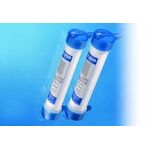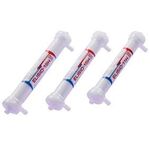Dialyzer
What is Dialyzer?
A dialyzer is a key component of a dialysis machine, often referred to as an artificial kidney. It is used in hemodialysis to filter waste products, excess fluids, and toxins from the blood when the kidneys are not functioning properly.
Inside the dialyzer, there are thin tubes called hollow fibers. As blood flows through these fibers, a special cleaning fluid called dialysate surrounds them.
What Does a Dialyzer Do?
A dialyzer helps clean the blood when the kidneys can't do it on their own. It is used during hemodialysis and works like an artificial kidney. The main things a dialyzer does are:
- Removes waste products like urea and creatinine from the blood.
- Gets rid of extra fluid that the body doesn’t need.
- Balances minerals like sodium, potassium, and calcium.
- Keeps important things like blood cells and proteins in the blood.
What are The Uses of a Dialyzer?
Uses of a Dialyzer:
A dialyzer is used during hemodialysis to clean the blood when the kidneys can’t do it on their own. It removes waste, extra water, and toxins from the body. Dialyzers are mainly used for people with chronic kidney disease (CKD) or kidney failure. They are also used in ICUs for very sick patients who need continuous blood cleaning, known as CRRT (Continuous Renal Replacement Therapy).
Benefits of a Dialyzer:
- Removes Waste and Toxins: The dialyzer helps clear out harmful substances like urea and creatinine from the blood, which can make a person sick if they build up.
- Balances Fluids and Minerals: It helps keep the right levels of water, salt (sodium), potassium, and other minerals in the body. This prevents problems like swelling or dehydration.
- Acts Like an Artificial Kidney: For people whose kidneys don’t work anymore, the dialyzer becomes a lifesaving tool, helping them live longer and manage their health.
- Improves Daily Life: By cleaning the blood regularly, it helps reduce tiredness, swelling, and other symptoms, so the person feels better and can live a more active life.
Understand Dialyzer Price and Models:
In India, the price range of dialyzers starts from ₹623.00 to ₹5,282.00. The price may depend on the types, features, and models.
S.no | Best Dialyzer Models | Price ₹ |
1 | ₹872.00 | |
2 | ₹663.00 | |
3 | ₹623.00 | |
4 | ₹785.00 | |
5 | ₹900.00 | |
6 | ₹754.00 | |
7 | ₹771.00 | |
8 | ₹728.00 | |
9 | ₹5,282.00 | |
10 | ₹1,224.00 |
Main Dialyze Parts:
- Outer Casing (Housing): A plastic tube-shaped body that holds everything together. It’s usually transparent, so you can see inside.
- Hollow Fibers (Membrane): Very thin, hair-like tubes made of special materials. Blood flows through these fibers. The walls of the fibers act as a filter to remove waste and excess fluid.
- Blood Inlet Port: This is where the blood enters the dialyzer from the patient’s body.
- Blood Outlet Port: This is where the cleaned blood leaves the dialyzer and goes back into the patient’s body.
- Dialysate Inlet Port: The special cleansing fluid (dialysate) enters the dialyzer here and flows around the outside of the hollow fibers.
- Dialysate Outlet Port: After collecting waste and extra fluid, the used dialysate exits the dialyzer from this port.
How Does the Dialyzer Machine Work?
A dialyzer is a special filter used in hemodialysis to clean the blood when the kidneys can't do their job.
Here's how it works step by step:
- Blood is taken from the patient’s body using a dialysis machine.
- The blood flows into the dialyzer, which has many tiny tubes called hollow fibers.
- Dialysate, a special fluid, flows around the outside of these fibers. It helps pull out waste, toxins, and extra water from the blood.
- The walls of the hollow fibers have tiny pores. These pores allow small waste particles and excess fluid to pass through, but they keep important things like blood cells and proteins inside.
- The cleaned blood then flows out of the dialyzer and is returned to the patient’s body.
What Are The Different Types of Dialyzer?
Dialyzers are special filters used in dialysis machines to clean the blood. There are different types, based on how they work and whether they can be used again
Let’s Look at Them One By One:
1. Low-Flux Dialyzer. This type removes small waste items like urea from the blood. It has tiny holes in its filter and is usually used in regular dialysis. It's cheaper but doesn't remove bigger waste particles as well.
2. High-Flux Dialyze.r This one can clean both small and larger waste particles from the blood. It works faster and does a more thorough job. It’s better for patients who need stronger cleaning during dialysis.
3. Reusable Dialyze:r These dialyzers can be used again after proper cleaning and disinfection. They help save money and reduce medical waste. But they must be cleaned carefully to avoid infection or damage.
4. Single-Use Dialyzer. This type is thrown away after one use. It is the safest option because there's no chance of contamination from previous use. It's ideal when hygiene is a top priority, but it costs more.
Where to Buy a Dialyzer?
If you're looking for a good place to buy a dialyzer, Biomed Supplier is a name you can trust. We make sure that every dialyzer we offer is reliable, safe, and reasonably priced. Whether you're buying for a hospital, clinic, or dialysis center, we've got you covered with products that meet medical standards and deliver dependable performance.
Why Choose Biomed Suppliers For Dialyzers?
- Safe and Approved Products: All our dialyzers are certified and tested for quality. You can be confident that you're getting a safe and effective product.
- Budget-Friendly Rates: We keep our prices competitive without cutting corners on quality, so you get value for your money.
- Different Types Available: From low-flux to high-flux, and single-use to reusable, we have multiple options to suit different treatment needs.
- Works with Most Machines: Our dialyzers are made to work smoothly with most dialysis machines, so compatibility won’t be an issue.
- Support You Can Count On: Not sure which dialyzer to choose? Our team is here to help you find the right one and answer your questions even after purchase.
With Biomed Supplier, you're not just buying a product—you’re getting peace of mind and support every step of the way.
What to Keep in Mind Before Buying a Dialyzer?
Before you buy a dialyzer, it’s important to check a few things to make sure it works well and is safe for the patient. Picking the right one helps clean the blood properly and avoids problems during treatment.
Here are some key points to think about:
- Dialyzer Type – Decide whether you need a low-flux or high-flux dialyzer based on the patient’s condition.
- Membrane Material – The filter inside can be made from different materials. Choose one that’s gentle on the blood and suits the patient’s needs.
- Single-Use or Reusable – Some dialyzers are used once and thrown away, others can be cleaned and used again. Pick what’s practical for your setup.
- Brand and Quality – Go for trusted brands known for good quality and safety standards.
- Cost – Make sure it fits your budget, but don’t compromise on quality.
- Machine Compatibility – Always check if the dialyzer works with your dialysis machine.
Frequently Asked Questions:
What is a dialyzer used for?
A dialyzer is used to clean the blood in people whose kidneys are not working properly. It removes waste, extra fluids, and toxins from the body.
What is the price range of a dialyzer?
Dialyzer price typically range between INR 700 to INR 6,000, depending on the type, brand, and quality.
What is the difference between high-flux and low-flux dialyzers?
High-flux dialyzers remove both small and larger waste particles from the blood, while low-flux dialyzers remove only small waste particles like urea and creatinine.
How many times can a dialyzer be reused?
A dialyzer can be reused several times if properly cleaned and checked, but it depends on the patient's condition and hospital guidelines. Some are meant for single use only.
Popular Categories:
Dialysis Equipment | Dialysis Machine | Peritoneal Dialysis Equipment | Hemodialysis Machine | Dialysis Tubing | CRRT Machine | Nipro Dialysis Machine | Fresenius Dialysis Machine | B Braun Dialysis Machine | Hemodialysis(HD) Catheter | Perm Catheter | ECG Machine | Single Channel ECG Machine | 3 Channel ECG Machine | 6 Channel ECG Machine | 12 Channel ECG Machine | Ventilator Machine | ICU Ventilator | Oxygen Concentrator Machine | Portable Oxygen Concentrator | Home Oxygen Concentrator | Nebulizer Machine | DVT Pump | Defibrillator | AED Machine | Cardiac Monitor | Multipara Monitor | Pulse Oximeter | Patient Monitor | Fetal Monitor | BiPAP & CPAP Machine | Suction Machine | OT Table | C Arm Machine | Laryngoscope | Anaesthesia Machine | Patient Warmer | Autoclave Machine | X Ray Machine | CR & DR System | Ultrasound Machine | MRI Machine | CT Scan Machine | Littmann Stethoscope | TMT Machine | Holter Monitor | Spirometer Machine | Audiometer | EMG Machine | EEG Machine | Stretcher | Hospital Chair | Hospital Beds | Hospital Trolley | Biochemistry Analyzer | CBC Machine | Centrifuge Machine | Urine Analyzer | Lab Shakers and Rotators | ESR Analyzer | Surgical Microscope | ECG Paper | Insulin Pump | Syringe Pump | Feeding Pump | Oximeter | Stethoscope |


